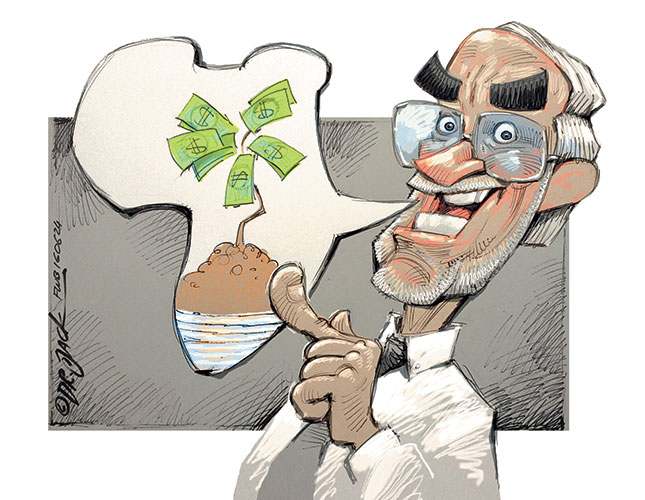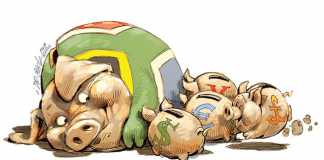
Photo: Dr Jack
Over the past four years, a prolonged commodity price slump, structurally lower growth in China, and a lethargic European economy have joined forces to lower the GDP growth trajectory in sub-Saharan Africa (SSA).
READ:Is hydroponics the answer to global food challenges?
Recently, the prospect of a stricter monetary policy in the US has also served to subdue global growth prospects, although the International Monetary Fund (IMF) expects global growth to rise marginally to 3,2% in 2016 (up from an estimated 3,1% in 2015).
The latest IMF global growth forecasts paint a gloomy picture for SSA in 2016, with only 3% GDP growth expected, but a substantial recovery is expected next year. The IMF expects real economic growth for SSA to return to the 5% level in 2018.
Economic outlook
It is clear that the latest IMF forecasts for countries in Africa are predicated on commodity prices remaining at the low levels recorded towards the end of 2015. This has resulted in a weak growth outlook for countries that rely heavily on commodity exports, including the three largest economies in SSA (Nigeria, South Africa and Angola). However, large divergences exist for the growth outlook within SSA, and the top three are weighing the region down.
Expected GDP growth for Côte d’Ivoire for 2016 is 8,5%, and Tanzania and Senegal’s economies are expected to grow 6,9% and 6,6% respectively. At the bottom end of the scale, Angola’s GDP is expected to expand only 2,5%, Nigeria’s 2,3%, and South Africa’s a depressing 0,6%.
An end to the serious drought in several southern African countries and a reversal of the five-year commodity cycle slump remain key to the SSA region’s growth outlook. There is also a constant need for improved public sector corporate governance and the expansion of basic infrastructure. There may be good news in the offing for the first two counts – most metal and mineral prices have improved handsomely since the end of last year and any further momentum in upward commodity price trends could lead to significantly higher growth than the current IMF forecasts.
Furthermore, the World Meteorological Organisation seems confident that the strong El Niño weather system will gradually decline during the second quarter of 2016, and may be replaced by a system that promises average to above average rainfall.
Food security lacking
The Global Food Security Index (GFSI), developed by the Economist Intelligence Unit (EIU) and sponsored by DuPont, considers three core pillars of food security – affordability, availability, and quality and safety. It covers 109 countries, including 28 from the SSA region.
Nine of the 10 lowest-ranked countries are from the SSA region, which gives a clear indication of the substantial potential that lies in developing the agriculture sector.
The improvement of food security arguably represents the single most important objective that should be pursued by governments in southern Africa.
According to the index, only two countries in SSA have a good food security environment, namely South Africa and Botswana; five countries are ranked as having a moderate environment (Ghana, Côte d’Ivoire, Uganda, Cameroon, and Senegal), while all other countries in the region require improvement.
A society that experiences hunger also falls prey easily to low levels of immunity to a variety of diseases, and health is therefore compromised when food security is lacking.
The world is littered with debilitating effects on the welfare of societies in countries where governments have pursued policies that support discredited ideologies such as extreme socialism and nationalisation, which do not incentivise surplus production for profit. Zimbabwe, Venezuela and North Korea serve as recent examples.
Policymakers that are sincere about improving the living standards of their citizens will take the improvement of food security seriously, and prioritise strategies and initiatives aimed at reducing the vulnerability that accompanies under-nourishment. This includes cooperation with high-income countries that have attained the maximum degree of food security.
Water remains crucial
It is fitting in an El Niño season to draw particular attention to the indispensable role of water in society in general, and agriculture in particular.
According to most authoritative references on resource economics, water represents one of the only natural limits to economic growth, and it is quite literally the lifeblood of primary food production.
The United Nations has warned that global water use is growing at twice the rate of global population growth. Unless this trend is reversed, two-thirds of the world’s population will face so-called ‘water stress’ by 2025. Working more carefully and effectively with water is therefore one of the greatest challenges facing the world today.
Although food production is estimated to account for more than two-thirds of the earth’s water footprint, lower water usage among urban households also has an important role to play in preserving water. A comprehensive strategy aimed at the efficient use of water encompasses all the user groups in society.
Water conservation policies will require adaptation to the characteristics of a particular country, as large differences exist across the global water footprint.
In Africa, water insecurity remains a vexing problem, as confirmed by data from the 2015 GFSI, and also a recent survey by Afrobarometer, involving 54 000 interviews in 36 African countries. Despite some infrastructure improvements, the results indicated that almost half (45%) of the continent’s citizens went without sufficient clean water for home use during the past year. One-third of surveyed communities lack access to a piped-water system, and two-thirds lack access to sewage infrastructure.
According to this survey, Namibia has the highest level of water security among countries surveyed (measured as a % of people with access to sufficient water) scoring 80%, followed by Ghana with 75%, and South Africa with 70%. The worst performing countries are Senegal with 50%, while in Cameroon and Mozambique less than 40% of the population have access to sufficient water.
The results of the Afrobarometer survey are fairly closely correlated with the GFSI data, showing that access to potable water plays a significant role in the reduction of undernourishment, and also contributes to lowering the prevalence of poverty.
Narrowing the GDP gap
It is encouraging to note that Africa is slowly but surely narrowing the gap in economic prowess with advanced economies. In 2015, the combined GDP of the 12 largest economies in SSA amounted to almost US$1,3 trillion (R19,4 trillion) –more than the combined GDP of Austria, Finland, Greece, Ireland, and Portugal.
The next upswing in the commodity cycle, especially metals and minerals, will undoubtedly hasten the pace of the relentless convergence of per capita income levels between Africa and Europe.
Several SSA countries have an abundance of agricultural resources (land and water), and economic policies in some countries are increasingly focusing on improving the performance of the agriculture sector by, among other things, investing in irrigation, storage facilities, transport modes, and training programmes.
As food production represents the mainstay of many African economies, significant gains in the global competitiveness stakes could be achieved by increasing the agriculture sector’s productivity.
This article was originally published in the 24 June 2016 issue of Farmer’s Weekly.













